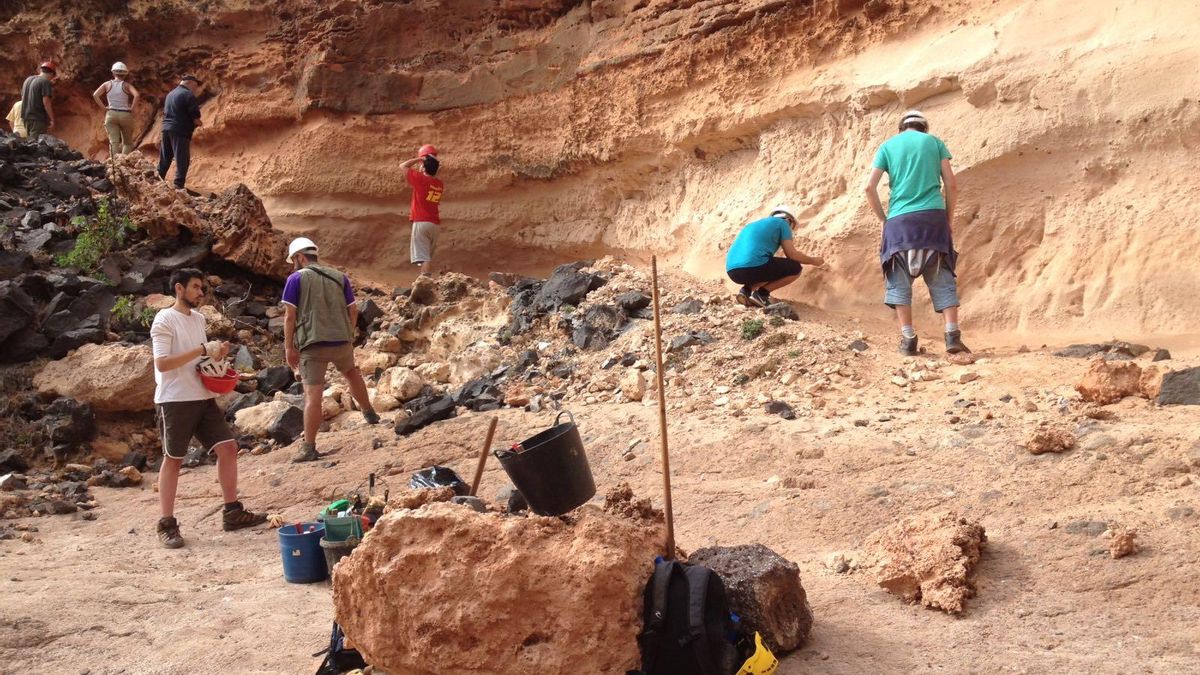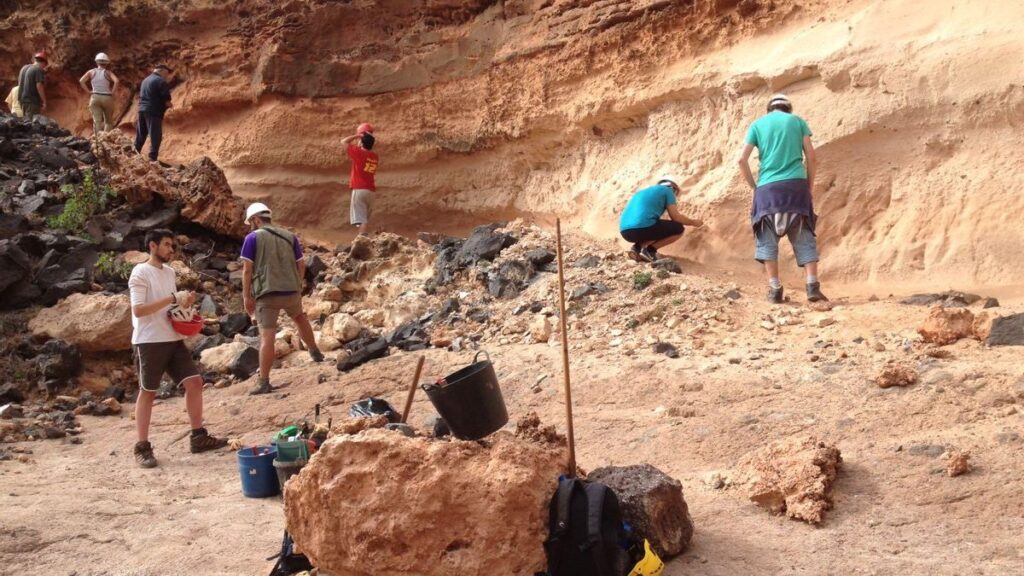A groundbreaking discovery in Lanzarote
Recent research by scientists from the Catalan Institute of Palaeontology and other institutions has overturned a long-held belief about the Canary Islands’ ancient past. The fossilised eggs found in the north of Lanzarote last century are not from a descendant of the ostrich, as was previously thought. Palaeontologist Antonio Sánchez Marco confirmed this breakthrough to our publication, following his team’s recent article in the international journal Fossil Studies. The scientists also raise concerns about the lack of protection for the three unique sites on the Canary Island where these eggs from the archipelago’s first terrestrial fauna were discovered.
Not an ostrich, but an elephant bird
So, if they aren’t from ostriches, what bird do these eggs belong to? The scientific team has no doubt that the eight-and-a-half eggs located across three sites in the north of the island, along with dozens of shell fragments, are from ratites. Dr. Sánchez explains that this is “a group of large, flightless birds.” Today, living ratites include ostriches in Africa, cassowaries and emus in Australia and New Guinea respectively, and rheas in South America. The extinct species include the Australian moas, a type of ostrich that inhabited parts of Africa, Europe, and Asia, and the elephant birds—the group to which the fossil remains found in Lanzarote belong.
The Lanzarote eggs, and this is the major revelation of the article published just a few weeks ago, “are from elephant birds,” an extinct group of ratites. “Elephant birds and ostriches are two distinct lineages of ratites. Several phylogenetic studies point to diverse relationships. Ratites are a very ancient group of birds that acquired this constitution as far back as the Paleocene.” This conclusion not only clarifies the origin of the eggs but also challenges the long-standing belief that elephant birds were a species exclusive to Madagascar.
How did flightless birds cross the sea?
A common characteristic of all ratites is that these birds are flightless. This presents a fascinating puzzle: how did they reach an island if they couldn’t fly? Researchers have grappled with this question for decades. Some hypotheses, such as Lanzarote initially being part of the African continent, have been discarded. Geologists and volcanologists are clear that all the Canary Islands emerged from the bottom of the Atlantic due to complex eruptive processes. In fact, Famara, in northern Lanzarote where the three palaeontological sites are located, was originally a separate island.
Sánchez is certain that “they had to have arrived by crossing the sea.” To cover a distance of over a hundred kilometres, specific circumstances must have facilitated such a complicated journey. Experts theorise that “the animals that arrived in Famara were swept along by the Canary Islands Current,” potentially aided—as one hypothesis suggests—”by major river floods caused by heavy rains in the Atlas Mountains. These floods could have swept animals from the Sus and Draa valleys, which empty their waters near the eastern Canary Islands. At the current speed of the Canary Current, the animals could have arrived in four days.”
As the scientists note in their article, it’s important to remember that “the modern ostrich, emu, and rhea are all good swimmers.” The journey wasn’t made by elephant birds alone. Other animals also had to arrive, probably predatory reptiles that fed on the eggs of these swimming birds that colonised Lanzarote. Sánchez explains: “We know there was a predator of the ratite eggs because we have found small shell chips, less than a centimetre in diameter, that are produced when teeth press into the eggs. A land animal with jaws capable of biting and fragmenting such large eggs must have been a crocodile or another enormous reptile.”
The ancient timeline of Lanzarote’s first colonists
The most reliable dating indicates that the eggs are four million years old, an update from an initial estimate of six million years. The latest study on the dating of the eggs and the stratigraphy of the sites was published in 2016 in the Journal of African Earth Sciences. But how long did these birds inhabit Lanzarote? The researcher clarifies that it is “difficult to estimate how long this fauna could have lived on what was then an island half the size of present-day Lanzarote,” because the three main sites, plus other outcrops, only cover a small sector. However, between the dating of the lower basalts and the upper basalts, there is a gap of about 400,000 years, which would be the maximum timespan for that sector of the island.
These palaeontological sites are unique in the Canaries. Dr. Sánchez tells us: “There are no known cases of birds like those of Lanzarote on other islands. It is a singular phenomenon. Nor have ostriches crossed over subsequently.” He adds that “it is also important to note that the Canaries have not been colonised by other ratites, like ostriches, which are good swimmers. Something unusual happened in that region about 4 million years ago.”
The discovery and the sites
The discovery of these large eggshells for science is credited to German geologist Peter Rothe, who made them available to Franz Sauer, then the leading specialist in ratite eggshells. Sánchez continues, “Rothe probably did not discover the eggshells himself but learned of them because it was common knowledge in the Haría area [north Lanzarote] that large eggs were found in Valle Grande and Valle Chico. In these places, calcarenite has been extracted for lime since ancient times. Every now and then, an egg would appear that people would keep for themselves.”
The main sites are Valle Grande 1, Valle Chico, and Fuente de Gusa. The first two are on the east face of the Famara massif; Fuente de Gusa is opposite La Graciosa. Palaeontologists from the Universitat Autònoma de Barcelona (UAB) began investigating them in 2010. Sánchez’s team has conducted eight campaigns, the last in 2019; their final conclusions are summarised in this report and were disseminated scientifically in August in the article “Unraveling the strange case of the first Canarian land fauna.”
Protection: a pending assignment
The first intervention in Valle Grande and Valle Chico was carried out by Rothe. There was also another campaign in the early 1980s at these sites by scientists from Tenerife’s Museum of Nature and Archaeology (MUNA). Sánchez confirms that the MUNA “holds fossils from these sites, including some interesting complete ratite eggs.” The eggs and thousands of fragments excavated by palaeontologists from the Catalan Institute of Palaeontology, from both elephant birds and turtles and snails, are now in the custody of the Lanzarote Island Council (Cabildo).
Despite their immense scientific value, the protection of these unique sites is literally non-existent. “These sites have no protection whatsoever,” states Antonio Sánchez definitively. They are not even declared Assets of Cultural Interest (BIC). This lack of status means that anyone could access the sites and loot them, risking the loss of irreplaceable clues to the island’s ancient history.


